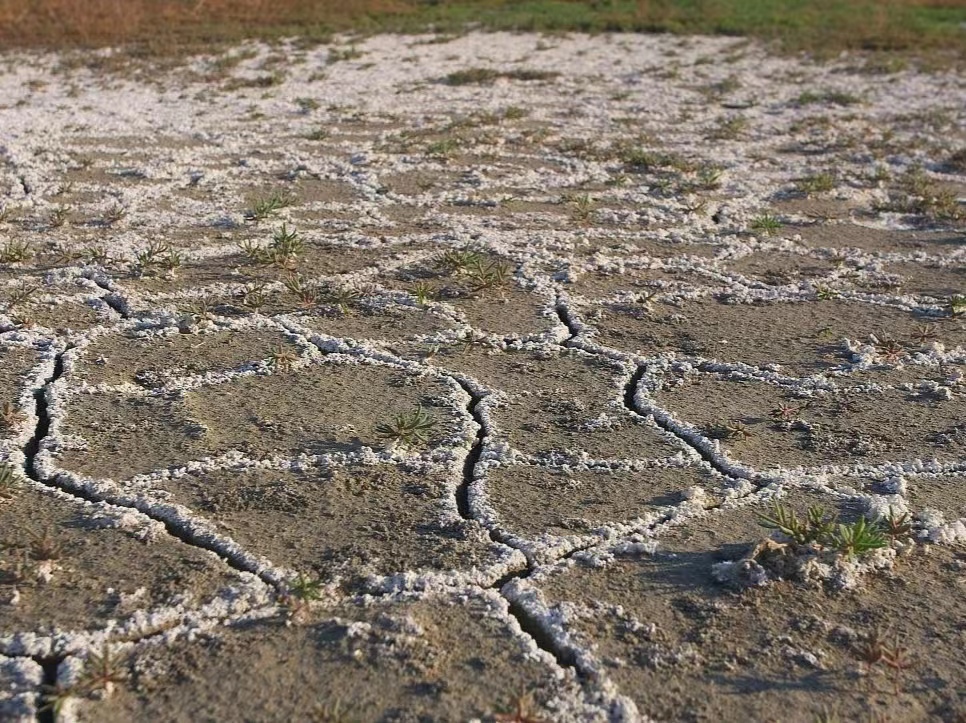soil salinization
土地盐碱化Soil salinization
1、 The Definition: It refers to the process in which the salt of the soil bottom or groundwater rises to the surface with the capillary water, and the salt accumulates in the surface soil after the water evaporates. Refers to the accumulation of soluble salt in the surface of the soil phenomenon or process, also known as salinization.

2、The formative factor:
(1) Natural element: When for some reason, the water table rises, or the water level is large in the rain season, the probability of soil salinization will increase, especially in the area near the sea, which will be relatively more serious. Secondly, some relatively closed terrain, because the salt can’t be discharged, will also be aggravated.
(2) Human element: Unreasonable irrigation leads to the rise of groundwater level; Excessive use of pesticides and fertilizers all year round will also aggravate soil salinization to some extent. Planting a single crop and nutrient imbalance in the soil also have an impact.

3、 Distribution in China
China's saline soil is distributed in 19 provinces and regions, including Liaoning, Jilin, Heilongjiang, Hebei, Shandong, Henan, Shangxi, Xinjiang, Shaanxi, Gansu, Ningxia, Qingdao,Jiangsu, Zhejiang, Anhui, Fujian, Guangdong, Inner Mongolia and Tibet. According to the natural geographical conditions and the soil formation process, it is divided into 8 sub-regions, such as the coastal wet-semi-humid sea saline area, the Northeast semi-humid - semi-arid steppe-meadow saline area, the Huang-Huai-hai semi-humid - semi-arid arid meadow saline area, the Ganxin desert saline area, the Qinghai extreme desert saline area and the Tibet Alpine desert saline area, which are used to guide the production practice.

4、 Harm
(1) Affect plant’s growth
Planting crops on salinized land, will cause the serious deficiency situation, and the symptoms of weak growth, yellow, wilting, and weak roots are very common. From the outside, the crops are lifeless, and in serious cases, the roots die and the whole plant dies.
(2) Reduce production
Crops grown in salinized soil, the yield will be more or less affected, because the crop can’t be absorbed and metabolized normally on the above, if it is not too serious, the yield is certain, if the salinization is particularly serious land, directly no harvest.
(3) Return to farming
When salinization occurs seriously, the above is not suitable for the growth of crops, can only be forced to abandon the farmland, this phenomenon is not without, once this situation, we can imagine, our life will be much harm.

5、 Ameliorative measure
(1)Chemical improvement measure
Chemical improvement measures are the methods of improving saline soil by applying chemical amendments and mineral fertilizers. Commonly used chemical amendments are organic or inorganic fertilizers, mineral fertilizers, calcium sulfite, desulfurized gypsum, phosphogypsum, ferrous sulfate, polymer amendments and soil comprehensive amendments. The principle is to improve the physical and chemical properties of soil and inhibit the occurrence of salinization through acid-base neutralization. The soil structure in salin-alkali land is poor. Organic fertilizer can decompose microorganisms and form humus to promote the formation of soil aggregates, increase soil aeration and permeability, and enhance soil buffering capacity, and form sodium humate with NaCO3 to reduce soil alkalinity. Meanwhile, sodium humate can stimulate plant growth and enhance salt resistance. Decomposition of organic matter in humus fertilizer will form organic acids, which can not only neutralize soil alkalinity, but also enhance the decomposition of nutrients and increase the availability of phosphorus. Therefore, rational application of organic fertilizer plays an important role in improving saline soil and enhancing soil fertility.
(2) Bioimprovement measures
The above-ground growing part of plants has a shielding effect, which can reduce the evaporation of soil water and the rate of salt accumulation on the surface. The salt absorption of plants can reduce the salt content of soil. The penetration of plant roots into the soil can change the physical properties of soil and promote soil desalination. As for physical and chemical improvement measures, biological measures have low cost, environmental protection and effective, and can produce economic benefits, which is popular with farmers.
(3) Comprehensive improvement measures
Physical measures are effective, but the engineering amount is large, the cost is high, is not permanent, and is limited by water resources, it is not easy to promote chemical measures are effective, but if used improperly, it is easy to cause secondary pollution to the environment, and a large amount of water is needed after the application of amendments, which is difficult to apply and the economic cost is expensive biological measures can reduce soil salt. But it can’t completely solve the problem of salinization. After many years of practice, it is found that soil salt evolution is a complicated process, and only one control measure can’t achieve the best effect of improvement. In recent years, in arid and semi-arid areas, comprehensive treatment measures such as washing and desalting, deep tilling and extensive planting of salt-tolerant plants have been used to solve the problem of soil salinization.





